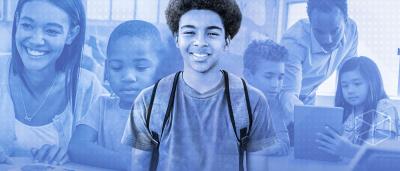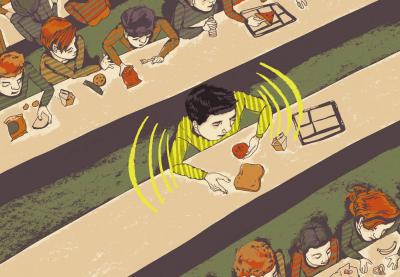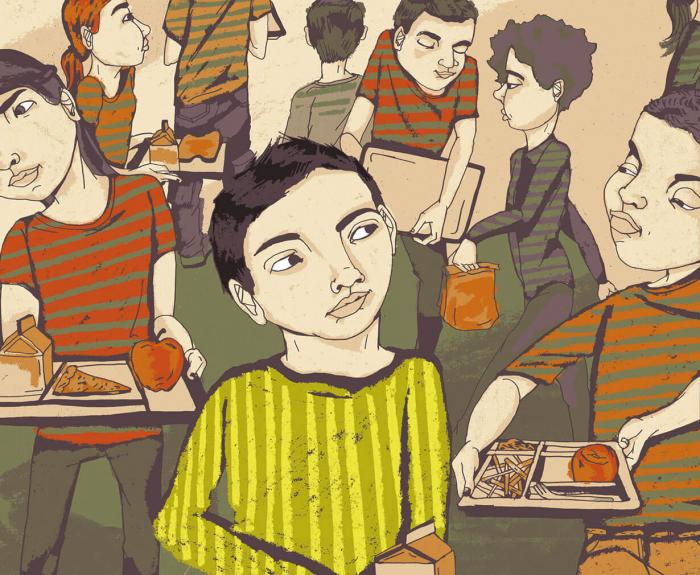The two teachers who asked for my help didn’t mince words. They said that students were calling Mathew, the new 7th grader, “weird” and “obnoxious,” even “disgusting.” When pressed for details, they explained that he walked down the hallways with books piled high on his head. They said he picked his nose constantly, sometimes using both hands.
Other kids had already begun to isolate this new student. The boy also said things to students that seemed mean. To a student who had answered a question incorrectly, he yelled out, “Geez, you really are ignorant.” To a heavy student he asked, “Exactly how much do you weigh?” Normally understanding teachers were losing their patience.
Even if you’ve never had a student like Mathew, you probably know what it’s like to have a pupil who tests your tolerance. And the student who evokes a strong negative reaction in you is likely stirring similar feelings in classmates. Mathew’s situation demanded action. After getting support from the principal, Mathew’s parents and most importantly Mathew, I decided to conduct a “disclosure meeting.” Mathew’s classmates would be informed that he was coping with Asperger’s syndrome.
Asperger’s syndrome is a hidden disability. Physically, individuals appear perfectly normal. Their cognitive intelligence is average or higher. Yet they have great difficulty interpreting everyday social cues such as facial expressions or body language. As a result, they often impinge on others. Typically, they stand too close, interrupt conversations and continue to speak whether or not anyone is interested.
The disclosure meeting was based on the belief that we could nurture the middle schoolers’ innate compassion if we could help them to connect with Mathew’s emotional pain. As a psychologist, I have long been intrigued by a phenomenon that psychotherapists experience all the time but rarely talk about: Therapists don’t necessarily care about new patients who first walk into their office. Yet in nearly every situation, after the patient begins to talk about his or her deep suffering, something magical happens. The therapist quickly comes to care, and often times care a great deal, for this person. And it’s not because therapists have a special capacity for caring. Self-help and 12-step groups are successful for precisely this reason.
But adolescents are famous for their self-centeredness. Were we hoping for too much from his classmates? Martha Snell, a professor of education at the University of Virginia, suggests that due to their stage of development, middle schoolers can barely help themselves from making fun of anyone who is different. She believes that those with disabilities are especially vulnerable.
However, my own experience with adolescents (and younger children as well) has shown that they tend to demonstrate great compassion to a child who is blind, in a wheelchair or has cancer. Their reactions are most likely to be insensitive and even brutal when the disability (such as depression or anxiety, obsessive-compulsive disorder, bipolar, Tourette’s or Asperger’s) is hidden and misunderstood.
The Disclosure Meeting
All of the adults present—Mathew’s parents, four teachers, the adjustment counselor and principal—were aligned in our purpose: Elicit an empathic response from the students. We felt that we could do this best by focusing on a few key messages:
We Are All the Same: We All Have Challenges
After introducing ourselves to the class, I began:
Oftentimes, it is easy to think that we are very different from one another. That no one is like us. But the reality is that we are more similar than different. … We all have our challenges. Some of you don’t see that well and need glasses. Some of you have learning disabilities—it may be difficult to read or do math. Some of you have trouble focusing or even sitting still. Many conditions are easy to recognize—a person has an assistive listening device or is in a wheelchair. But there are other conditions where you can’t see the person’s challenge.
Mathew, who you all know, has courageously chosen to share with you today that his challenge is Asperger’s syndrome. (Mathew had decided to come to the meeting, but sit in the back and remain quiet.) I continued:
One effect is that Mathew doesn’t read social cues as well as most of you do. For example, it is harder for him to understand if someone is kidding or being sarcastic. This leaves him very vulnerable—a person with Asperger’s might think someone is being nice when they are really making fun of him. It also means that you, all of you, as his classmates and decent human beings, have a responsibility not to take advantage of this vulnerability.
If You Think that a Student Could Benefit from a Disclosure Meeting ...
Speak with a professional at your school who is trained in the psychological well being of students. Lone teachers should not conduct disclosure meetings. There is the risk of traumatizing the student you are trying to help if he or she comes under attack by other students during the meeting or if more personal information is revealed than the student had agreed to disclose.
Before conducting a disclosure meeting, the only legal obligation of the school may be to attain parental permission. It is unethical, however, to conduct such a meeting without also attaining the student’s informed consent. Informed consent means that the student really understands the essence of what will be disclosed and any possible risks. Though these risks are quite minimal with a skillfully conducted meeting, students should be apprised of them. When a student has special needs, informed consent can be a sensitive and subtle task requiring the skills of a psychological professional.
A Workbook for Youth with Disabilities is an excellent source to help students decide whether to disclose or not.
Connecting with Another’s Emotional Pain Leads to Empathy
Mathew’s mother was terrific at helping students feel what it was like to be Mathew:
My son is wonderful, but believe me, I also understand how difficult he can be. He interrupts; I don’t know if he is listening; he stands too close. And there are times when he keeps talking when I just want him to keep quiet.
Her openness was a gift. His classmates didn’t need to use their energy denying their own negative feelings—enabling them to move on and make room for new feelings. She also spoke of her son’s suffering:
I am sure many of you don’t want to think what it would be like not to have any friends. Mathew has a lot of sadness that some other kids don’t seem to like him. He is confused. He doesn’t understand why no one wants to eat with him during lunch or sit with him on the bus.
Disability ≠ Inferior
Mathew’s mother had a deep understanding of how her son, like anyone with a disability, is much more than his disability. She went on:
What really frightens me is that these things might scare you off, that they will get in the way of seeing his terrific qualities. You’ve probably noticed that Mathew, like lots of people with Asperger’s, is very smart and has an amazing memory. And it’s as though he can’t tell a lie or even a fib. So if you want to know the truth about something—“What do you think of my new haircut? How’s my paper?”—he is going to tell it like it is. If you want someone who can be a genuine friend, loyal and truthful, Mathew is your guy.
Risk vs. the Payoff
Despite our high hopes, we feared the meeting could backfire. Would the students use details of Mathew’s disability to open their hearts, or could it become fodder for their jokes and derision? By appealing to their sense of decency, the principal let students know how wrong it would be to use this information against Mathew. He began:
I would like you to close your eyes and begin to think about whatever embarrasses you the most … That thing that you can barely admit to yourself … The thing about yourself that you hope no one notices, ever.
Now, if you can, imagine making the decision to have a meeting with your classmates so that everyone can talk about this thing that most embarrasses you. You decide to do it because you believe that it will be good for your own growth, good for your classmates and good for your school. Imagine the courage you would need to have to make this decision … Now, please open your eyes.
I’m sure that I don’t need to say how cowardly it would be for someone to use the information to give him a hard time. Thank you.
Students Respond
The principal finished up and immediately a large hulking boy raised his hand. I held my breath. Just the week before, I had met with this boy because a couple of students had accused him of bullying. I feared that he might use this meeting as a high-profile opportunity to flex his muscles at Mathew’s expense.
“I have something I need to say,” the boy said. He then turned around to face Mathew. Mathew looked away. “I know I didn’t treat you good. I was kind of mean. But I didn’t know you had this.” A tear rolled down the boy’s face. Then to the amazement of everyone, he started to sob. Through his tears, the boy continued on, “I mean I am really, really sorry.”
As the rest of us caught our breath after this boy’s soulful expression of remorse, a girl yelled out, “I really love you, Mathew,” adding as she looked around the room for confirmation, “We all love you.”
Then a girl who was known for her conscientiousness asked for clarity: “Let’s say that I’m working in a small group with Mathew, and he goes on about something that doesn’t have anything to do with the topic. Do we just ignore him?” Mathew’s mother was quick to respond, “He wants to know when he is turning off people. You are doing him a favor when you tell him.”
The Impact Over Time
In the following weeks, I was in frequent contact with Mathew and his teachers. There were some obvious positive changes. He no longer ate alone in the cafeteria. There were no reports of exasperated teachers or kids making fun of him. His mother reported that he was developing a friendship with a classmate.
A year after the disclosure meeting, I met with Mathew and some of his teachers. Students always seem eager to guide a lost classmate in the right direction. The disclosure meeting helped Mathew’s classmates recognize how lost he was in social situations. Now, they were taking satisfaction in helping him find his way.
If he was taking too much air time, a peer would tell him. If Mathew was publicly picking his nose, a classmate would let him know that he should stop. But now the students’ intention was to help rather than harass him. This enabled Mathew to stay open and consider whether he wanted to change his behavior.
Mathew made extraordinary changes in only a year. The student feedback was far more powerful and effective than any possible adult intervention. The speech therapist who was charged with helping him learn how to behave in social situations recently said there was no longer a need for her services. Although a diagnosis of Asperger’s doesn’t simply go away, a casual observer would never pick up that there was anything unusual about this boy.
The changes to his peer community were no less profound. They had strengthened their connection to one another by establishing a new social norm: Acts of compassion were viewed as a sign of strength and character.
By embracing this quirky student, his classmates could all experience the safety of knowing that their environment was less judgmental and more accepting. His classmates seemed happier—bonded by the responsibility and freed by the safety that is created whenever people decide to take care of one another.
Helping the Unlikeable Student
It is difficult to admit—even to ourselves—that there are students we don’t like. It’s embarrassing: Aren’t we supposed to have good feelings for all of our students? Ideally, yes, we would like all of our students. But we are real people, dealing in the real world with some very difficult students.
So how do you generate positive feelings for the student whose behavior distracts the whole class from your carefully planned lesson? Can you really feel compassion for the boy who makes fun of other students?
While our feelings can seem beyond our control, there are steps you can take:
1. Acknowledge your feelings.
The sooner you acknowledge your negative feelings, the sooner you can let them go. If the goal is to nurture the compassion of your students, you can begin by acting compassionately toward yourself. This means accepting yourself— feelings and all.
2. Remember: It’s not about you.
There are reasons the truly difficult student is acting the way he is. A student’s challenging behavior—even when you are the focus—is not personal. For the student abused at home, you might be the symbol of authority that has mistreated him. The child who has become a prickly thorn in your side could be reeling from a family crisis—a raging custody battle can leave a child without any solid ground under his feet. The anger spewing from your pupil might be the result of a parent getting fired and the financial meltdown that follows. Students’ stress is often compounded by directives from parents not to say a word to anyone.
There could be a hidden physiological or psychological
explanation: A general anxiety disorder can make it impossible for anyone, even a conscientious student, to stay seated and attentive. The adolescent’s explosive outbursts that wreak havoc in your classroom may be the result of an emerging mental illness.
3. Lean into your aversion.
Try to make meaningful contact with the difficult student. Instead of sending her to the office, ask to speak after class. For these students, going to the office is business as usual, a conversation with a caring teacher is not.
4. Listen.
Students will often share their personal stories if you can listen without judgment. Listening is a gift to difficult students. When they are able to accept this gift, it can make a real difference in your life and theirs.
5. Consider the context of their lives.
As a committed teacher, you want your pupils to learn your subject. But sometimes mastery of a subject must be secondary. When a young person is alienating the most important people in her life, she is struggling with the very meaning of life. Her most basic need, like all of us, is to feel respected and loved. If you can offer this to a student who feels neither, you have fulfilled your responsibility as a teacher—and as a human being.
6. Be vigilant with these students.
No matter how small the improvement, let them know you notice and that you respect their efforts.
7. Appreciate the multiplier effect
of your kindness.
You set the tone for your class. Students are much more likely to treat each other with respect and tolerance when the teacher is kind to all students—even those who are the most challenging.



